#Kohinoor Diamond History
Explore tagged Tumblr posts
Text
The Kohinoor Diamond is one of the most famous and valuable diamonds in the world, with a rich and intriguing history. Its name, "Koh-i-Noor," means "Mountain of Light" in Persian. The diamond has been a source of fascination and controversy for centuries, passing through the hands of various rulers and nations.
2 notes
·
View notes
Link
Know the history of Kohinoor diamond in Hindi. 13वीं शताब्दी में दक्षिण भारतीय हिंदू राजा काकतीय वंश के समय वर्तमान गोलकुंडा की खान से यह हीरा निकाला गया है|
3 notes
·
View notes
Text

Just finished this. A super-breezy read that straddles mythology, history, storytelling and a bit of geology. Also, this whole story is super Bollywood- twists, turns, debauched kings (did you know there are eyewitness accounts of Ranjit Singh, yes *that* Ranjit Singh, doing the dirty in public on an elephant? With a lady too, haww) courtesans with hearts of gold, torture - the whole shebang.
Super entertaining. Highly recommended.
#books and literature#reading#william dalrymple#anita anand#non fiction#history#india#indian history#pakistan#pakistan history#england#colonialism#kohinoor#diamond#jewels
1 note
·
View note
Text
I think i know why Christian was set to Marry Devi... (My theory i uploaded on reddit was removed by the admin idk why?)
It was bugging me from the moment when Christian said that he wanted to marry Devi from the very beginning although dozens hid this fact from her to spar her to get married to Christian. But why he wanted to marry her? Christian didn't know Devi and the latter came way before Devi met Ian. so what was he insisted to marry on marrying and devi only. also if it was because he show her portrait then he could've remember her when they meet for the first time.
After thinking about it so much i couldn't come to theory or connect the dots that not until i was sitting with my dad watching the news (I am Indian btw) and suddenly the news was talking about the most famous and precious jewel of india "Kohinoor" i am not sure how many of you know about this but this diamond it very "precious", "Priceless" and "CURSED" yes this diamond is "cursed" it was called cursed because of that soley diamond in the past war has fought for 500 years or more. and it has killed everyone who tried to posses that diamond the biggest empire has collapsed because of this mere diamond although it's not a mere diamond. because in reality, this diamond belongs to the gods.
The Koh-i-Noor Diamond isa a 186-caratt diamond with a curse affecting only men. According to folklore, a Hindu description of the diamond warns that “he who owns this diamond will own the world, but will also know all its misfortunes. Only God or woman can wear it with impunity.” Throughout history, the gem traded hands among various Hindu, Mongolian, Persian, Afghan and Sikh rulers, who fought bitter and bloody conflicts to own it. Every prince whohadf the diamond would ultimately lose his power if not his life. For over 500 years the stone changed hands in gruesome battles and vicious coups.
The kingdom of Golconda(current day state of Telengana,India), The khilji Empire,The Tughlaq Empire,The Lodhi Empire,The Mughal Empire,The Maratha Empire,The kingdom of Persia,The Durrani Empire,The Afghan Khanate,The Sikh Empire all collapsed one behind the other while owning the Koh-i-noor Diamond.The height of the curse can be seen in the fact that even World level Empires crumbled below the weight of the curse.The British East India company owned the Jewel since the Annexation and Disbandment of the Sikh Empire. But only 7–8 years following the looting of the jewel,the revolt of 1857 literally destroyed the east IndiaCompanyy from its roots.
Historical records indicate the diamond was acquired by the British in 1849 and given to Queen Victoria in 1850. To heed its legend, the diamond has since only been worn by women, including Queen Alexandra of Denmark, Queen Mary of Teck and the late Queen Elizabeth, The Queen Mother, wife of King George VI.
In 1936, the stone was set into the crown of the wife of King George VI, Queen Elizabeth (later known as the Queen Mother). The British Royal family was aware of the Curse of the Koh-i-Noor, and from the reign of Queen Victoria the Kohinoor diamond has always gone to the wife of the male heir to the British throne
Currently, it is set as one of the jewels within a British monarchy crown that is kept at the Tower of London Jewel House.
I am telling you the whole story because?
here is the dots to this theory:
Sharma owns the mines for gemstones, diamonds, and crystals not only in Bengal but in very different places on all over India.
Devi's brother died while trying to save the bride.
Those who came to kill people talked about letting "Women alive and killing all the men" A simple person may think they said it to use them later on. if so then why was Rati killed?
Devi becomes the heir of the Sharma household, and Kamal insists on making Devi the heir why? i understand that is because Kairas was his best friend but he could've easily let Devi's uncle become the heir.
For some reason Kamal agreed to marry off Devi to Ian suddenly? like that man fought for 5 years against everyone then why did he turn his back suddenly?
Also I personally thin Ian chose devi for specific reasons too, like right now she is the head of Sharma's house but even when she wasn't he wanted to marry her and only her.
The Koh-i-noor might be found on devi's mine. as it holds the power of god and specifically it is cursed. As it said that "Only God or Woman can wear it with IMPUNITY" where Impunity simply means exemption from punishment or freedom from the injurious consequences of an action.
Or Devi personally is or is the koh-i-noor itself. Or Maybe British knew about the diamond and it's real power. They have stole diamonds from Taj Mahal too but they knew that the diamond who belongs to god holds its own power so they might need someone for that. Devi. Not only she is related to Maa Kali, she is girl and if they choose Devi and then found diamond form her mine then they can ask her to give it to them as in original i mean in reality that's how the koh-i-noor to the queen, they manipulate the royal family livin' in the England making them into thinking it was a simple diamond was given to the queen but in reality it was more then that!
I think they knew about the mines or something similar related to it.
49 notes
·
View notes
Text
Im listening to the girl historians kohinoor diamond episode, love the vibes, love the summary of 200 years of history around a cursed diamond, thank you Rhys Naylor, 10/10 , will never forget that there's a curse
2 notes
·
View notes
Text
History of Kohinoor diamond
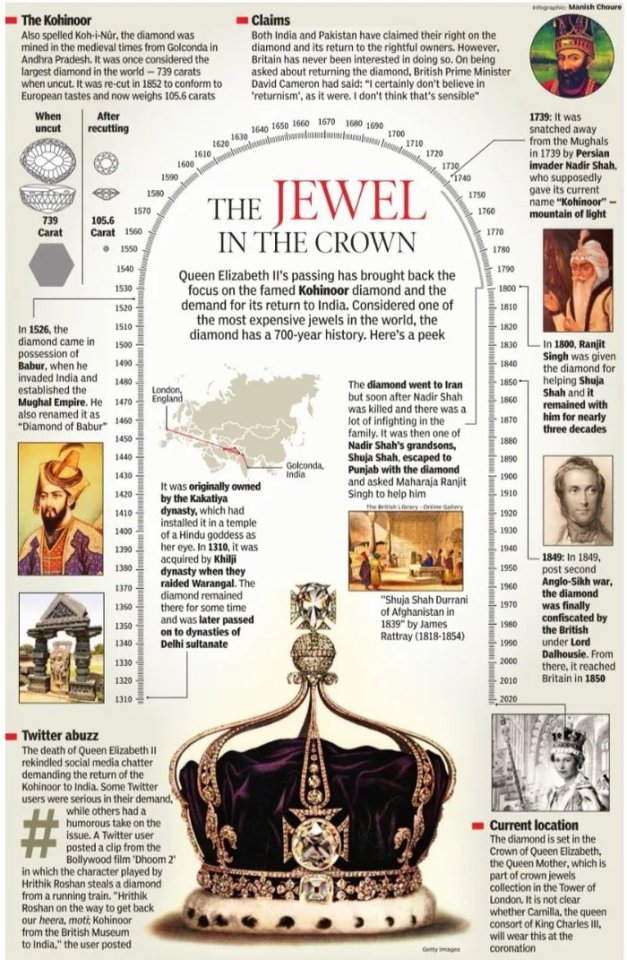

7 notes
·
View notes
Note
Honestly Kohinoor diamond one is a great idea, here's more idea to consider -
1. Glorification of Mughal empire in India (when it was tragically and explicitly hinduphobic)
2. Emma Chamberlain wearing Maharaja Bhupinder Singh’s stolen necklace ?????? Wtf
3. Speaking of Taylor Swift, you can talk abt why it's like, people have to justify before saying anything other than her praises? Yk, you can't even criticize her because the Internet Swifties will follow you to death
4. I know you have Indian heritage (or are directly an Indian I'm sorry I may be wrong, apologies wkgjjw) anyway, you can maybe talk abt Kashmir Files or Kerala Story. Like why aren't We ready to accept that these things are real, especially the Kashmir one. (And do u know kerala story is Banned in KERALA make it make sense)
These are some hot topics and tbh I'm not brave enough to send them off anon. But we're mutuals <3
Ummm are you an angel because!!!! Damn???? Thank you so much!!! My thoughts:
Since I started reading up on the Kohinoor I am madly interested in the imperial history of the Indian sub-continent so the Mughal Empire is deffo something I want to look into
Not gonna lie the Patiala necklace thing lowkey made me laugh because it was so random like. some youtuber just shows up one day wearing a piece of lost treasure to a hollywood fancy dress party??? but yeah i could totally take a similar route with this one as with the Kohinoor
Swifties are definitely somewhere on the same level of protective as ARMY and um. While I respect everyone's right to defend their opinions, some of the fandom retaliation that happens on the internet (Swfities or otherwise) definitely calls for legal investigation.
Ummmm it's the way I was literally born in Kerala and have never heard of the Kerala Story???? Or the Kashmir Files??? Thank you for bringing this to my attention I will immediately be falling into a rabbithole
#political#dilli rambles#ask#anon#angel anon#definitely going to do some deep dives and see if I can use these in my project#or even future projects#ah i love this place#💌#studyblr#answered
6 notes
·
View notes
Text
Why “The Stolen Kohinoor Diamond” Won't Make An Appearance At King Charles III's Coronation
— May 4, 2023 | By Lauren Frayer

The Kohinoor diamond, set in the Maltese Cross at the front of the crown made for Britain's late Queen Mother Elizabeth, is seen on her coffin at London's Westminster Hall. Camilla, the diamond in her coronation crown, but will modify Queen Mary's crown, using diamonds from Queen Elizabeth II's personal collection. Alastair Grant/AP
LONDON — Of all the glittering British crown jewels, one will be conspicuously absent at King Charles III's coronation: the Kohinoor diamond.
Legend has it the 105-carat diamond — whose name means "mountain of light" in Persian — was found on a bank of the holy Krishna River in southern India at least 800 years ago. From there, the story goes, it spent centuries hidden inside a golden statue at a Hindu temple.
It passed through Mughal, Persian, Afghan and Sikh empires before ending up in the hands of Queen Victoria in the mid-19th century.
Along the way, people came to believe it was cursed. Calamity is said to have struck many a male royal who wore it. One strapped the diamond to his bicep. Another folded it into his turban. Most met grisly deaths — murdered, betrayed, defeated.
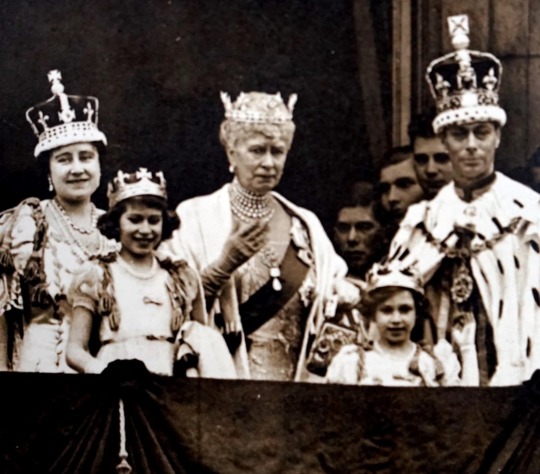
Photograph taken during the coronation of King George VI and Queen Elizabeth the Queen Mother, pictured with their children, Princesses Elizabeth and Margaret, and Queen Mary of Teck. Universal History Archive/Getty Images
So it's thought that only women — especially queen consorts — can wear the Kohinoor safely. Elizabeth, the wife of King George VI, wore it to her coronation in 1937, and again to her daughter Elizabeth II's in 1953. (There is no known record of Queen Elizabeth II wearing the diamond).
According to tradition, King Charles III's wife Camilla would be the next to wear the jewel at this weekend's coronation ceremony. But she will wear a different crown, one with 2,200 smaller diamonds.
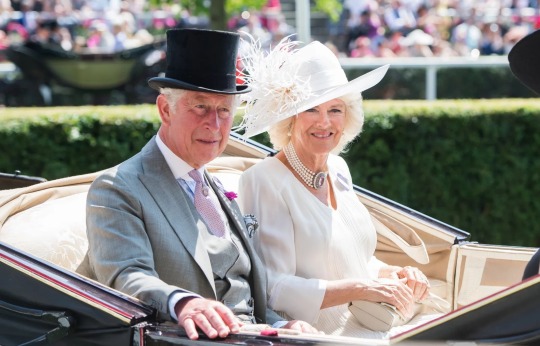
Camilla and Charles attend Royal Ascot 2017 at Ascot Racecourse. Samir Hussein/Getty Images
That's because the Kohinoor has become a focus of anti-colonial anger. India wants the diamond back.
And it's not alone. So do several other nearby countries — including Iran and Afghanistan — whose own royals and rulers, over the centuries, possessed the diamond. For now, though, the British royal family has no intention of parting with the giant gemstone.
The museum where it's kept on display, in the Tower of London, is a popular destination for South Asian tourists.
"I've learned my best swears in front of the Kohinoor, in three different languages," says historian Anita Anand, the coauthor of Kohinoor: The History of the World's Most Infamous Diamond. "Every time you bring someone over from India or Pakistan, they just swear at it! Swear at the fact that it's here."
After Queen Elizabeth died last year, the Indian government said it has repeatedly raised the issue of repatriating the Kohinoor with the British government.
And this winter, Buckingham Palace made an announcement: The royal family had decided to leave the controversial gem out of the coronation ceremony for Charles and Camilla.
For now, it remains locked in the Tower of London, advertised as a "symbol of conquest" — firmly on British soil.
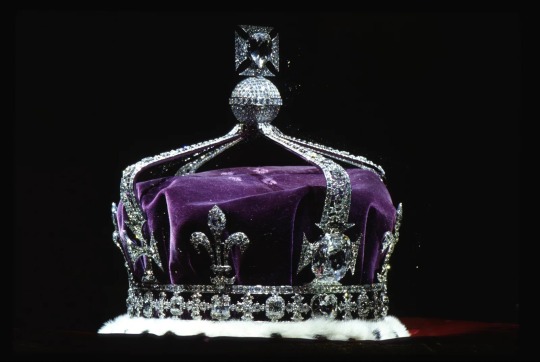
The crown of Queen Elizabeth the Queen Mother (1937), made of platinum and containing the Kohinoor diamond and other gems. Tim Graham/Getty Images
A Diamond the Size of a Coconut
Centuries before humans began mining diamonds deep underground, gems were only discovered after working their way up to the Earth's surface. And one of the places they seemed to do that most was the area of the Golconda alluvial mines, in southern India.
That's where, 800 or so years ago, someone went to take a bath in the Krishna River and apparently stumbled upon the biggest diamond then known in the world. Legend has it that it was the size of a coconut.
"People used to go to the rivers and take baths, and there were no soaps or cosmetics at the time, so they used the wet clay next to the riverbanks and applied it to their bodies," explains Mohan Devarapalli, 32, who gives Kohinoor-themed tours in southern India. "So while [collecting] the clay, they found the diamond."
They considered it a gift from the holy river and took it to their rulers, the 12th century Hindu kings of the Kakatiya dynasty. At the time, India was full of warring states, and the kings needed to keep their diamond safe.
So they hid it in plain sight — inside the eye socket of a large golden statue of the Hindu goddess Durga, in a temple that's still in use today, on the edge of a lake in the modern-day city of Warangal. One eye was glass, the other was diamond. But they looked identical.
"One of the [goddess'] eyes was the diamond, which no one knew — except the kings — because it looked like glass. Even the priests, they would not have known it," Devarapalli says. "It was a top-secret place to hide the diamond."
It worked — for a couple of centuries, at least.
The Diamond Becomes an Object of Violent Conquest
Rumors spread about this giant diamond guarded by a goddess. And when the Kakatiya dynasty was vanquished, around the 14th century, invaders from the north pillaged all the temples in the region and captured the gemstone.
"It's the nearest thing to the ring of power in Lord of the Rings. Whenever it goes, it stirs up anger, greed, murder and bloodshed!" says historian William Dalrymple, Anand's coauthor.
Experts have confirmed from the diamond's geology that it did come from the Golconda area of southern India.
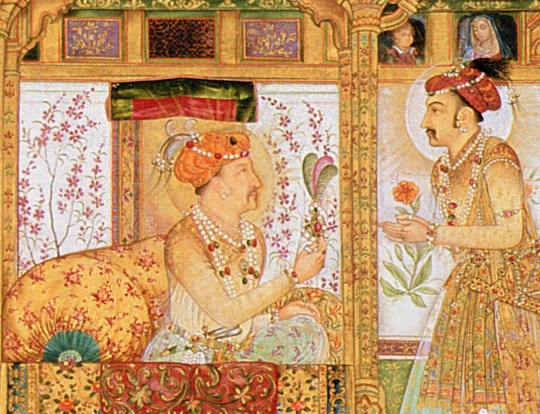
The opulence of Shah Jahan's court was a marvel in 17th century India. The Mughal emperor embedded the Kohinoor diamond in the Peacock Throne, his seat of power. Pictures from History/Getty Images
"But beyond that, its history is enormously disputed," Dalrymple says. "There's almost no record of it until it's on the top of the Peacock Throne, which is built in the 1640s by Shah Jahan, who's the same guy who built the Taj Mahal."
By the 17th century, much of India had been conquered by Muslim emperors, known as the Mughals. One of them, Shah Jahan, embedded the diamond in the Peacock Throne, his seat of power — which eventually was captured by another warlord with a weakness for diamonds.
"An Iranian leader called Nadir Shah defeats the enormous Mughal army. From Iran, [the diamond] then enters the hands of Ahmad Shah Abdali, who is the founder of Afghanistan," Dalrymple explains. "So the Afghans feel equally strongly that this is their stone."
Around this time, the diamond came be known as the Kohinoor. It was also around this time when legends of curses started to mount.
"In Indian astrology, a pure man without sin — a great man — can wear a diamond without a problem. But anyone who is flawed, or any diamond which is flawed, can bring terrific bad luck," Dalrymple says. "This whole mythology of cursed diamonds actually begins in Indian astrological texts."
By the time the British arrived on the scene — first as the East India Company in the 17th century, and then as colonial rulers — the diamond was only worn by women.
That suited Queen Victoria just fine.
A Colonial Gift For Queen Victoria
In the mid-19th century, British diplomats befriended a 10-year-old Punjabi Sikh prince, the Maharaja Duleep Singh, who'd inherited the Kohinoor. They took the boy's diamond as part of an 1849 treaty marking the end of the second Anglo-Sikh war — and presented it to Queen Victoria. She wore it in a dangling bracelet, and later had a giant brooch made to hold the diamond, which she wore to sit for a famous portrait.
That loss of the Kohinoor is still felt — memorialized — in India to this day.

Ruins of the historic Golconda Fort on the outskirts of Hyderabad in southern India. Experts have confirmed that the Koh-i-noor diamond came from the Golconda area. Majority World/Universal Images Group/Getty Images
In a sound-and-light show for tourists at the 11th century Golconda Fort in the southern city of Hyderabad, where the Kakatiya kings once ruled, the recorded voice of Bollywood's biggest star, Amitabh Bachchan, extolls the Kohinoor's brilliance and bemoans where it is today.
"The Kohinoor is still in Britain. This is just a replica," Bachchan's voice bellows in the darkness, as a giant hologram of a diamond is projected onto one of the fort's walls.
Tourists shake their heads.
"The British never apologized about anything," says Saudamini Sharma, 25, touring the fort. "They're the ones who came and tried to, you know, quote unquote 'civilize people.' But civilized people don't steal — don't take away stuff and never return it."
India's Claim To The Kohinoor
There are growing calls to return the Kohinoor. But to where? Over the centuries, it's been held in what is now India, Pakistan, Iran and Bangladesh. Even the Taliban claim it's theirs.
From the return of Jewish art looted by the Nazis to colonial artifacts in British museums, Western governments in recent years have started to address questions of ownership of archaeological and cultural heritage. A London museum recently returned the Benin Bronzes to Nigeria. Greece is asking the British Museum to return the Elgin Marbles.

Benin Bronzes are displayed in Berlin in 2022. Germany returned 22 of the looted objects to Nigeria in December. A London museum is also returning Benin Bronzes. Michael Sohn/AP
But the U.K. government and royals have rarely commented on the Kohinoor. In 2010, then-Prime Minister David Cameron, asked about it on a trip to India, said returning the diamond would set a dangerous precedent for British institutions.
"What tends to happen with these questions is that if you say yes to one, you suddenly find the British Museum would be empty!" Cameron told New Delhi Television. "I think I am afraid to say, to disappoint all your viewers, it is going to have to stay put."
Meanwhile, the British sell tickets (currently, about $37 for adults) to see the Kohinoor — and have done so since 1851, when the diamond was the star attraction at the World Exhibition at the Crystal Palace in London.
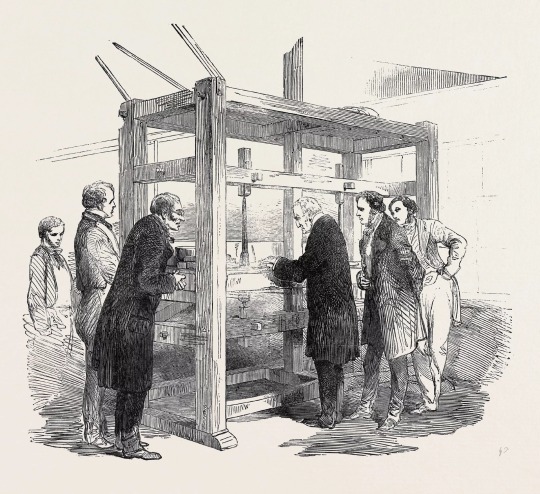
Re-cutting the Koh-i-Noor diamond, 1852. Universal History Archive/Getty Images
It was for that exhibition that the British royals had the diamond cut down — lopped off at least 85 carats. The diamond had already been whittled down from its legendary coconut size over the centuries, as part of efforts to eliminate imperfections or possibly even steal parts of it. In Victorian Britain, the taste was for "brilliant" cut diamonds, which required a reshaping of the gem to refract more light.
"To Indians, it's actually a perfect, perfect metaphor for what India went through: It was reshaped and re-cut and diminished into something that suited a British palate and British needs," Anand says.
"We [in Britain] don't really learn about the history of empire! It's painted as if it's something very long ago, not really interesting — and yet it shapes the world we live in today," Anand says. "It's always glimmered in my life. If you are a British Asian, you know about the Kohinoor."
Last year, India and Pakistan celebrated 75 years since winning their freedom from the British crown. But for many, the story is incomplete as long as the British crown still has their diamond.
— NPR.Org
3 notes
·
View notes
Text
Majestic Matrimony: Luxurious Wedding Destinations in Hyderabad

Majestic Matrimony: Luxurious Wedding Destinations in Hyderabad
Hyderabad, known as the City of Pearls, is a vibrant blend of history, culture, and modernity. This city offers an array of luxurious wedding venues that can transform your special day into an unforgettable celebration. From regal palaces echoing tales of the Nizams to contemporary hotels that epitomize elegance, Hyderabad provides the perfect setting for a majestic matrimony. Here’s a look at some of the most luxurious wedding destinations in Hyderabad, each promising to make your wedding day truly spectacular.
Click Here More Deatils:https://www.oppvenuz.com/services/venues/Hyderabad
The Regal Charm of Palaces
1.Taj Falaknuma Palace
Perched 2,000 feet above the city, the Taj Falaknuma Palace is the epitome of opulence and grandeur. Built in 1894, this former residence of the Nizam offers a majestic setting for weddings. The palace’s Venetian chandeliers, intricate frescoes, and grand marble staircases provide a stunning backdrop for a royal celebration. Whether it’s the sprawling lawns, the Durbar Hall, or the Rajasthani Garden, every corner of the palace exudes luxury. A wedding at Taj Falaknuma Palace is not just an event; it’s an experience of timeless elegance and unparalleled hospitality.
Chowmahalla Palace
Chowmahalla Palace, once the seat of the Asaf Jahi dynasty, is another regal venue that embodies the grandeur of Hyderabad’s royal heritage. The palace complex, with its lush gardens, opulent halls, and stunning courtyards, offers a fairy-tale setting for weddings. The Khilwat Mubarak, the heart of the palace, is an exquisite venue for ceremonies and receptions, adorned with crystal chandeliers and antique furnishings. Hosting your wedding at Chowmahalla Palace is like stepping into a royal era, where every detail is crafted to perfection.
Contemporary Elegance of Hotels
The Westin Hyderabad Mindspace
The Westin Hyderabad Mindspace combines contemporary luxury with exceptional service, making it an ideal venue for modern weddings. The hotel’s spacious banquet halls, like the Grand Ballroom, can accommodate large gatherings, while the elegant decor and state-of-the-art facilities ensure a seamless celebration. The Westin’s lush lawns and poolside venues also offer beautiful settings for outdoor ceremonies and receptions. With its impeccable service and luxurious amenities, The Westin Hyderabad Mindspace promises a wedding that is both stylish and memorable.
ITC Kohenur
Located in the upscale area of Hitec City, ITC Kohenur is a masterpiece of luxury and sophistication. This hotel, inspired by the famous Kohinoor diamond, offers a blend of traditional and contemporary design. The Nizam Suite and the Peacock Suite provide an opulent setting for intimate gatherings, while the Deccan Pavilion and the Grand Ballroom are perfect for larger celebrations. The hotel’s culinary expertise, reflected in its gourmet menus, adds a touch of excellence to every wedding event. A wedding at ITC Kohenur is a celebration of grandeur and refinement.
Serene Garden Venues
Shamshabad Farmhouse
For couples seeking a tranquil and picturesque setting, Shamshabad Farmhouse offers a serene escape from the city’s hustle and bustle. The sprawling lawns, adorned with beautiful landscaping and water features, provide a charming backdrop for outdoor weddings. The farmhouse’s rustic charm, combined with modern amenities, creates a perfect blend of elegance and comfort. Whether it’s a daytime ceremony under the blue sky or an evening reception under the stars, Shamshabad Farmhouse offers a magical setting for your special day.
Golkonda Resort and Spa
Nestled amidst 13 acres of lush greenery, Golkonda Resort and Spa is a haven of peace and luxury. The resort’s beautifully manicured gardens, scenic lake views, and elegant banquet halls make it an ideal venue for a dream wedding. The Jasmine Garden and the Poolside Lawn offer enchanting settings for outdoor ceremonies, while the Durbar Hall provides a grand space for indoor celebrations. The resort’s luxurious accommodations and world-class amenities ensure that your wedding guests enjoy a comfortable and memorable stay.
Unique and Exclusive Venues
Fort Grand
Fort Grand, with its majestic architecture and expansive grounds, offers a unique and grand setting for weddings. The venue’s medieval-inspired design, complete with turrets and ramparts, creates a fairy-tale atmosphere. The Grand Arena, capable of hosting thousands of guests, is perfect for large-scale celebrations, while the smaller courtyards and gardens provide intimate spaces for private ceremonies. Fort Grand’s exclusive ambiance and grandeur make it a standout choice for a majestic matrimony.
Ramoji Film City
For a wedding with a touch of cinematic glamour, Ramoji Film City is an unparalleled choice. As one of the largest film studio complexes in the world, Ramoji Film City offers a variety of themed sets and venues that can bring any wedding vision to life. From royal palaces and picturesque gardens to contemporary settings and lavish banquet halls, the options are endless. The professional event management team ensures that every detail is meticulously planned and executed, making your wedding a truly spectacular affair.
Conclusion
Hyderabad’s luxurious wedding destinations offer a perfect blend of tradition, elegance, and modernity. Whether you choose the regal charm of historic palaces, the contemporary elegance of five-star hotels, the serene beauty of garden venues, or the unique exclusivity of themed locations, each venue promises to make your wedding day a majestic celebration. In the City of Pearls, where every corner is steeped in history and culture, your wedding will be a timeless and unforgettable affair, creating memories that you and your guests will cherish forever.
0 notes
Text

The Great Star is added to the sceptre, which is part of the British crown jewels. (Getty images)
After Queen Elizabeth's death, calls are now being made for the return of several diamonds, which adorn the British crown jewels. South Africa has joined the growing chaos seeking the return of Great Star of Africa, the largest known clear-cut diamond. Also known as Cullinan I, it was cut from the larger gem that was mined in South Africa in 1905, according to a report in CNN. The Great Star was handed over to the British royal family by the colonial rulers of Africa and is currently mounted on a royal scepter belonging to the Queen, the outlet further said.
Also Read | Besides Kohinoor, These 4 Items Were Also Taken Away By The British
"The Cullinan Diamond must be returned to South Africa with immediate effect," activist Thanduxolo Sabelo told local media, according to CNN. "The minerals of our country and other countries continue to benefit Britain at the expense of our people."
An online petition has been launched on change.org seeking the return of the diamond and it has been signed by more than 6,000 people.
Vuyolwethu Zungula, a member of the South African Parliament, posted a tweet demanding "reparations for all the harm done by Britain" and "return of all the gold, diamonds stolen by Britain".
Also Read | Queen Elizabeth's Death: Kohinoor Crown Will Go To Camilla, Says Report
ABC News said in a report that the 530.2-carat drop-shaped diamond was added to sceptre with Cross, a sacred object that dates back to the 1600s used during coronation ceremonies.
The diamond is on public display in the Jewel House at the Tower of London, the outlet further said.
The exact monetary value of the diamond is unclear, though its rarity and history makes it worth a fortune.
0 notes
Text
This is so true like I could go on a rant for this but I won’t. I literally have grandparents and great-grandparents who’ve gone through that period and that just hits so hard cause we aren’t talking about something centuries back. We’re talking about something IN LIVING MEMORY.
Honestly, almost every Indian family has a story from those times and the sheer audacity that they have to not even give a goddamn royal apology or return the billions of things they stole from us. FORGET MONEY THEY STOLE OUR HERITAGE
(Whoop, now I’m ranting)
Did you know that the Indian school system (the one they’re literally using right now) is actually one devised by the British. They destroyed our education system and put this one in place specifically designed to brainwash us and forget our culture our teachings our knowledge and insert some superficial WRONG shit in its place. Oh and did you know that some of our history textbooks today still show the British in a positive light? It makes my blood freaking boil
Also DO YOU KNOW WHAT THE BRITISH DID? Let me name a few of the top of my head? Have you heard the one about the Enfield rifle that sparked the great revolt of 1857? the Bengal famine? Oh oh and of course the JALIANWALA BAGH ‘EPISODE’? Like they don’t even have the basic human decency to issue a formal apology? Don’t get me started on the money they looted from India- 45 TRILLION DOLLARS (off the top of my head). What about the Kohinoor diamond?
And we’re mourning her. Thank you for coming to my TED talk
This is probably my last post on the whole “Liz is dead” situation but I want to talk about my great grandmother, who is currently 92 years old. When I was growing up, hell even now, she’d tell me a lot about her own stories, mostly about how terrifying life was under both the British Raj and Nizam rule (her side of my family is from Hyderabad - Google the Nizams and the Razakars if you’ve never heard about them, that’s a whole other thing of its own).
Something I remember very clearly is her telling me about this one song she was forced to sing in her school - she went to a Christian convent school - and the song was about the greatness of “George Prabhu and Mary Rani,” aka George V, Elizabeth II’s grandfather. Recently my mom was able to film her singing this song so that we could listen to the lyrics, which are originally in Telugu, and roughly translated it means “we’re singing in honor of George and Mary, who are the rulers of India and have brought great fortune to India, and we see them as our father and mother.”
This is just a really difficult reminder that when we’re talking about why Elizabeth II and the royal family don’t deserve our respect or condolences, many of us have very personal stories that run deep through our families. “But she was a mother, a grandmother, a person” and I don’t care because she and her family were in the business of dehumanizing people and erasing their identities. “But she wasn’t responsible for India” fair enough, her darling grandfather had a great time doing that, but how about you go and talk to Kenya? Or anyone in Africa? Or the Caribbean? I’m sick and tired of being told to “not speak ill of the dead” when REALLY I and millions of others should be getting an apology from anyone who wants to “praise her legacy” and talk about how “revolutionary” she was.
edit: i got the george’s mixed up. george v is elizabeth ii’s grandfather. george vi is her father.
9K notes
·
View notes
Text
The Kohinoor Diamond is one of the most famous and valuable diamonds in the world, with a rich and intriguing history. Its name, "Koh-i-Noor," means "Mountain of Light" in Persian. The diamond has been a source of fascination and controversy for centuries, passing through the hands of various rulers and nations.
2 notes
·
View notes
Text
Significance of Jaipur in Gemstone Jewelry Industry, India
Indian art and beauty are well-known worldwide. When combined with gemstones the art of jewelry design is unsurpassed in beauty. The history of stones in India is extensive. India is the only nation in the previous 2000 years that have met the demand for extravagant "Gemstone Jewelry". We thrive from Handmade Jewelry to Custom Jewelry and Jewelry Casting while creating great modern and traditional beautiful jewelry which has a long list of Varieties. The magnificent archeological remains and breathtaking architectural designs are a thriving ancestor of the riches. Starting with the priceless Golconda diamonds and the spectacular the star of India which is also referred to as the blue star sapphire and of course the Kohinoor, India has also provided the most spectacular and valuable gemstone in the entire globe. In fact, it is also known as the unrivalled nation of jewels. Currently, Jaipur is the city that rules all roaring agencies in the nation.
0 notes
Text
Significance of Jaipur in Gemstone Jewelry Industry, India
Indian art and beauty are well-known worldwide. When combined with gemstones the art of jewelry design is unsurpassed in beauty. The history of stones in India is extensive. India is the only nation in the previous 2000 years that have met the demand for extravagant "Gemstone Jewelry". We thrive from Handmade Jewelry to Custom Jewelry and Jewelry Casting while creating great modern and traditional beautiful jewelry which has a long list of Varieties. The magnificent archeological remains and breathtaking architectural designs are a thriving ancestor of the riches. Starting with the priceless Golconda diamonds and the spectacular the star of India which is also referred to as the blue star sapphire and of course the Kohinoor, India has also provided the most spectacular and valuable gemstone in the entire globe. In fact, it is also known as the unrivalled nation of jewels. Currently, Jaipur is the city that rules all roaring agencies in the nation.
0 notes
Text
https://diamondsbymanee.com/history-of-kohinoor-diamond/
#diamonds#jewelry#earrings#necklaces#pendant#jewellery#jewlery#wholesaler#certified#diamond ring#online jewelry#diamond jewelry
1 note
·
View note
Text
thinking about the Kohinoor diamond that is one of the largest cut diamond in the world .
thinking of how it's been stolen from its home throughout history by invaders and imperialists.
thinking of how it sits on the British crown rn
thinking of the native people's belief that it's a cursed diamond because every dynasty and rule it went to, fell and went to ruins.
thinking if it absorbed the hatred and greed ppl sought it with. thinking if it'll curse its home if it comes back
#history#world history#india#indian history#colonialism#yt ppl#bring it home :(#i have belief that it will curse everyone who took it until it comes back home#mine#sorry im a history student and reading of my ancestors enrages me
0 notes